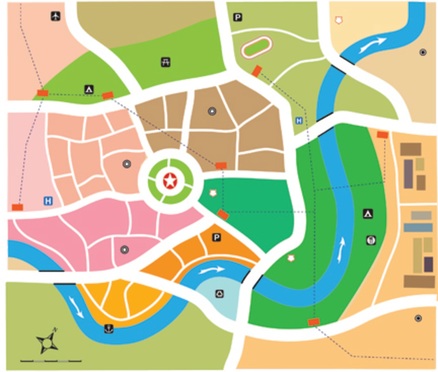 The ability to transfer floor area by zoning lot merger derives from two basic principles under the Zoning Resolution. First, under the definition of “zoning lot” set forth at ZR §12-10, it is permissible to merge one’s own lot with any other lot that is located on the same block and contiguous for a minimum of 10 linear feet. In particular, subdivision (d) of the definition states that a zoning lot may consist of “a tract of land … consisting of two or more lots of record contiguous for a minimum of ten linear feet, located within a single block, which … is declared to be … treated as one zoning lot for the purpose of this Resolution.” Second, the ZR regulates compliance on the basis of a zoning lot, not a tax lot or other lot of record. Therefore, after two parcels are merged into a single zoning lot, their compliance with all regulations, including floor area, is evaluated based on the lot area of the merged parcel. Since DOB will, following the zoning lot merger, analyze the floor area compliance based on the entire zoning lot, a zoning lot merger under subdivision (d) may be used to transfer unutilized development rights from one or more contiguous parcels to another that is under separate ownership.
The ability to transfer floor area by zoning lot merger derives from two basic principles under the Zoning Resolution. First, under the definition of “zoning lot” set forth at ZR §12-10, it is permissible to merge one’s own lot with any other lot that is located on the same block and contiguous for a minimum of 10 linear feet. In particular, subdivision (d) of the definition states that a zoning lot may consist of “a tract of land … consisting of two or more lots of record contiguous for a minimum of ten linear feet, located within a single block, which … is declared to be … treated as one zoning lot for the purpose of this Resolution.” Second, the ZR regulates compliance on the basis of a zoning lot, not a tax lot or other lot of record. Therefore, after two parcels are merged into a single zoning lot, their compliance with all regulations, including floor area, is evaluated based on the lot area of the merged parcel. Since DOB will, following the zoning lot merger, analyze the floor area compliance based on the entire zoning lot, a zoning lot merger under subdivision (d) may be used to transfer unutilized development rights from one or more contiguous parcels to another that is under separate ownership.
A zoning lot merger under subdivision (d) is required to be documented and evidenced to the DOB by a series of “zoning exhibits” that are intended to confirm that all parties that have an interest in the affected land, e.g., fee owners, ground lessees, lenders and easement holders, have consented to the formation of the zoning lot. This requirement dates from 1977 amendments to the “zoning lot” definition that were intended to address issues arising out of the litigation in Newport Assoc. v. Solow, 30 N.Y.2d 263 (1972). In Newport, a developer ground leasing property had, without the consent of the ground lessor, transferred the excess floor area from that property to an adjacent property it owned and incorporated them into the building he was developing thereon. The 1977 amendments were adopted (1) to avoid situations, such as that in the Solow case, in which parties with an interest in a property have their rights compromised without their consent, and (2) to ensure that the public land records show when and where such transfers had taken place.
This content has been archived. It is available through our partners, LexisNexis® and Bloomberg Law.
To view this content, please continue to their sites.
Not a Lexis Subscriber?
Subscribe Now
Not a Bloomberg Law Subscriber?
Subscribe Now
LexisNexis® and Bloomberg Law are third party online distributors of the broad collection of current and archived versions of ALM's legal news publications. LexisNexis® and Bloomberg Law customers are able to access and use ALM's content, including content from the National Law Journal, The American Lawyer, Legaltech News, The New York Law Journal, and Corporate Counsel, as well as other sources of legal information.
For questions call 1-877-256-2472 or contact us at [email protected]






